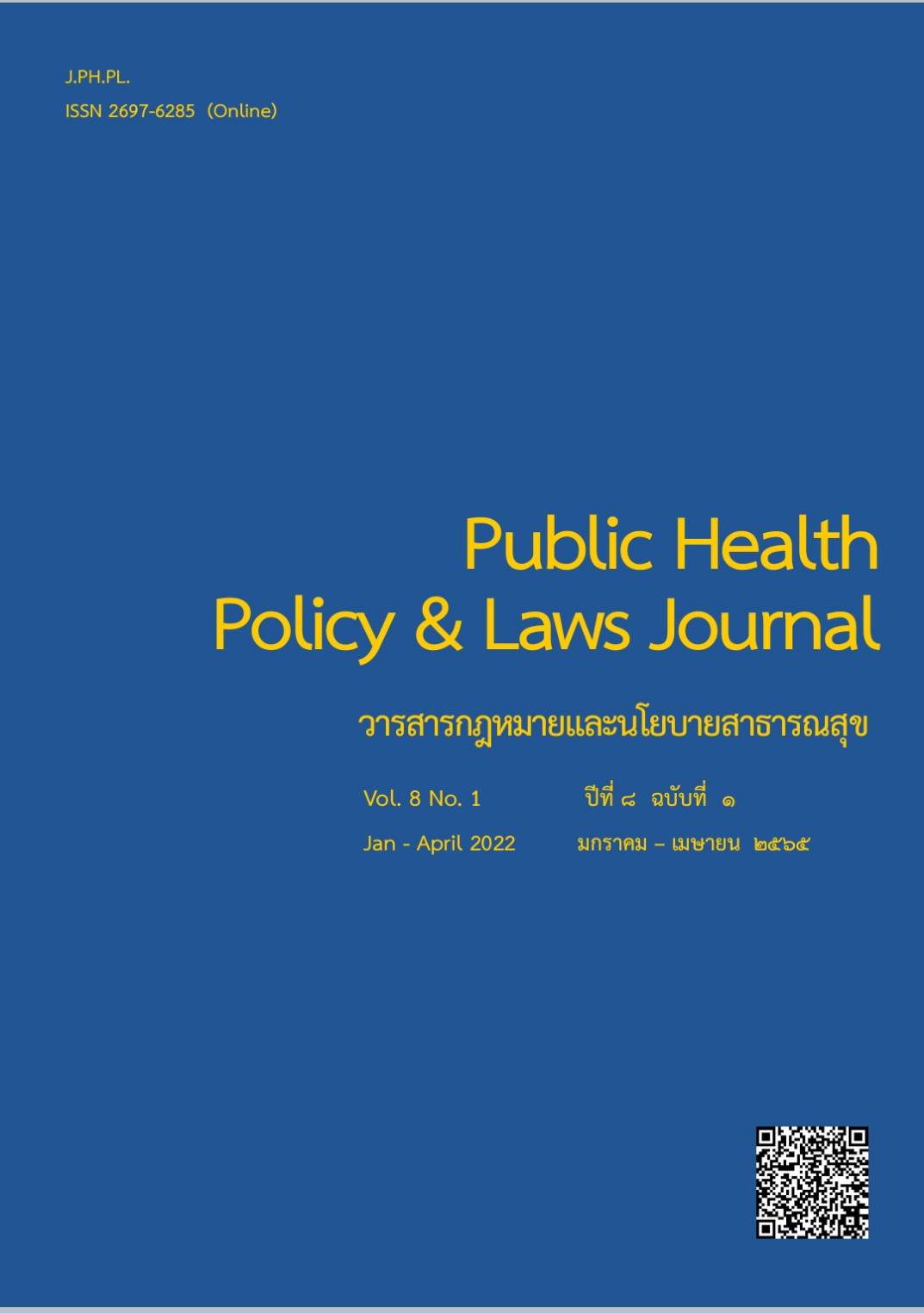An Ecological Model and Exclusive Breastfeeding
Keywords:
Exclusive breastfeeding, individual factors, interpersonal factors, organizational and community factorsAbstract
This descriptive study aimed to estimate the proportion of exclusive breastfeeding, and to identify its relationship with the ecological model: individual, interpersonal, organizational and community factors. A total of 140 mothers who took their children, under 12 months of age, to receive vaccination at Healthy Children Clinic of Thammasat Hospital during October 2020 to January 2021, participated in this study. Face-to-face interviews and self-administered questionnaires were used for data collection. The data were analyzed using quantity, percent, mean, standard deviation, simple and multiple binary logistic regressions to identify related factors with exclusive breastfeeding, at 5% level of significance.
The study results did not show any statistically significant relationship between individual, interpersonal, organizational and community factors with exclusive breastfeeding. But Adjusted Odds Ratio of more than 1.5 were the following factors: order of children, premature birth, husband's age, online breast milk support.
To encourage mothers to EBF her baby, emphasis should be placed on educating both mothers and husbands on exclusive breastfeeding during pregnancy, childbirth and the postpartum period. Online forms of breast milk clinics should be strengthened. Encouraging mothers for easy access to information and knowledge about breastfeeding. When mothers have difficulty with breastfeeding, she can easily consult and ask for advice from public health personnel, especially among mothers with more than one child and younger husbands.
References
จิรนันท์ วีรกุล. (2557).ปัจจัยที่มีความสัมพันธ์ต่อความสำเร็จในการส่งเสริมการเลี้ยงลูกด้วยนมแม่อย่างเดียวนาน 6 เดือนในโรงพยาบาลมหาวิทยาลัยนเรศวร.นเรศวรวิจัย : วิจัยและนวัตกรรมกับการพัฒนาประเทศ, 12, 746-757.
ฉวีวรรณ บุญสุยา. (2554). ประชากร การเลือกตัวอย่างและขนาดตัวอย่างในการวิจัยในประมวลสาระชุดวิชาสถิติและการวิจัยในการจัดการสุขภาพ หน่วยที่ 8 พิมพ์ครั้งที่ 3: กรุงเทพฯ : บริษัทเอเอ็นออฟฟิศเอ็กซ์เพรส จำกัด.
นิตยา สินสุกใส. (2555). การเลี้ยงลูกด้วยนมแม่: ประโยชน์ของนมแม่. พิมพ์ครั้งที่ 2 กรุงเทพฯ: ห้างหุ้นส่วนจำกัด พรี-วัน.
พรพิมล อาภาสสกุล. (2559).ปัจจัยที่เป็นอุปสรรคขัดขวางการเลี้ยงลูกด้วยนมแม่ของสตรีไทย. วารสารพยาบาลสาธารณสุข, 30(2), 133-146.
พรรณวดี ประยงค์. (2562). การใช้ประโยชน์จากสื่อสังคมออนไลน์ในการแสวงหาข้อมูลข่าวสารด้านการเลี้ยงลูกด้วยนมแม่ของแม่ศึกษากรณีเฟซบุ๊กแฟนเพจ“สุธีรา เอื้อไพโรจน์กิจ”. วารสารศาสตร์, 12(2), 40-43.
สำนักงานสถิติแห่งชาติประเทศไทย. (2563). โครงการสำรวจสถานการณ์เด็กและสตรีในประเทศไทย พ.ศ. 2562,รายงานผลฉบับสมบูรณ์. กรุงเทพมหานคร, ประเทศไทย : สำนักงานสถิติแห่งชาติ ประเทศไทย.
สุดาภรณ์ พยัคฆเรือง. (2555). ปัจจัยที่มีอิทธพลต่อการเลี้ยงลูกด้วยนมแม่ ใน กรรณิการ์ วิจิตรสุคนธ์, พรรณรัตน์ แสงเพิ่ม, สุพิณดา เรืองวิรัชเฐียร และ สุดาภรณ์ พยัคฆเรือง (บรรณาธิการ). การเลี้ยงลูกด้วยนมแม่, (พิมพ์ครั้งที่ 3). กรุงเทพฯ: ห้างหุ้นส่วนจำกัด พรี-วัน.
Bloom, B.S. (1971). Handbook on formative and summative evaluation of student learning.
Bronfenbrenner, U. (1973). Social ecology of human development.Brain and intelligence: The ecology of child development. Hyattsville: National Education Press;.
Grubesic, T. H., & Durbin, K. M. (2019). A spatial analysis of breastfeeding and breastfeeding support in the United States: the leaders and laggards landscape. Journal of human lactation, 35(4), 790-800.
Jessri, M., Farmer, A. P., Maximova, K., Willows, N. D., & Bell, R. C. (2013). Predictors of exclusive breastfeeding: observations from the Alberta pregnancy outcomes and nutrition (APrON) study. BMC pediatrics, 13(1), 1-14.
Jin, S. V., Phua, J., & Lee, K. M. (2015). Telling stories about breastfeeding through Facebook: The impact of user-generated content (UGC) on pro-breastfeeding attitudes. Computers in Human Behavior, 46, 6-17.
Kilanowski, J. F. (2017). Breadth of the socio-ecological model: Taylor & Francis.
Meedya, S., Fahy, K., & Kable, A. (2010). Factors that positively influence breastfeeding duration to 6 months: a literature review. Women Birth, 23(4), 135-145.
Palank, C. L. (1991). Determinants of health-promotive behavior. A review of current research. The Nursing Clinics of North America, 26(4), 815-832.
UNICEF. (2563). Infant and young child feeding. Retrieved 28 January 2021, Available from : https://data.unicef.org/topic/nutrition/infant-and-young-child-feeding/.
World Health Organization. (2003). Implementing the Global Strategy for Infant and Young Child Feeding: Geneva, 3-5 February 2003: meeting report: World Health Organization.
Downloads
Published
How to Cite
Issue
Section
License
Disclaimer and Copyright Notice
The content and information presented in articles published in the Journal of Law and Public Health Policy represent the opinions and sole responsibility of the respective authors. The editorial board does not necessarily agree with or assume any responsibility for the views expressed.
All articles, data, content, images, and other materials published in the Journal of Law and Public Health Policy are the intellectual property of the journal. Any individual or organization wishing to reproduce, distribute, or otherwise use the entirety or any part of such materials must provide proper citation.





